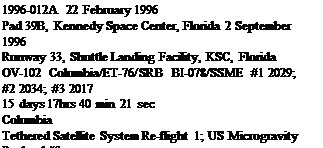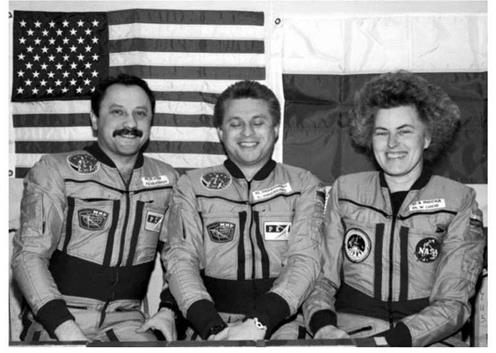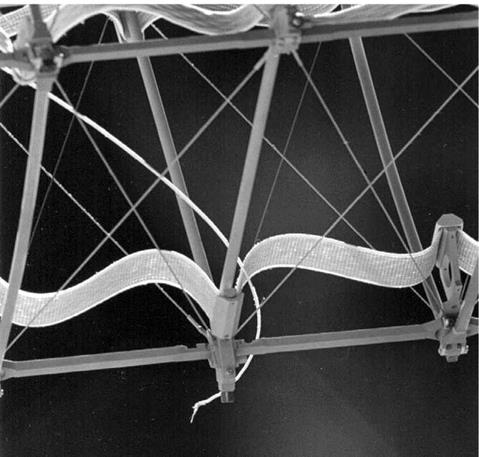. SOYUZ TM23
Flight Crew
ONUFRIYENKO, Yuri Ivanovich, 35, Russian Air Force, commander USACHEV, Yuri Vladimirovich, 38, civilian, flight engineer, 2nd mission Previous mission: Soyuz TM18 (1994)
Flight Log
After taking over from the EO-20 crew, the next resident crew for Mir had a busy programme of activities planned for their mission. They were to perform six EVAs, support the arrival of the final Mir science module (Priroda), and work with the second American to live on Mir, Shannon Lucid. In addition there was a change of cosmonauts in the subsequent resident crew and an extension both to Lucid’s mission and to the cosmonauts’ own stay on Mir.
The “two Yuris’’, as the press called them, were expecting to conduct a four-and – a-half month residency, but by July, continued problems over the construction of Soyuz rockets at the Samara factory meant that the next mission would have to slip and the cosmonauts were told they would have to fly a six-month mission. Their first EVA (15 May, 5 hours 52 minutes) featured the installation of a second Strela boom to allow easier movement to the repositioned Kristall module. Other EVAs would be performed after the arrival of STS-76 and the transfer of Shannon Lucid to the station.
Shannon Lucid had arrived at Mir on 24 March for what was planned as a 140-day mission but, again in July, following technical problems with the Shuttle SRBs and the decision to replace those assigned to STS-79 (the mission that would bring her home), her own residency was extended, eventually reaching 188 days, and setting a new US endurance record both for a single mission and for a career total. During the other EVAs conducted by the two Russian cosmonauts, Lucid would remain inside the station, monitoring the activities of her two colleagues.
|
“The two Yuris”, Usachev (left) and Onufriyenko with the second US resident astronaut Shannon Lucid |
The science module Priroda arrived on 26 April, and the following day was transferred to the left radial (+Z) port, completing the Mir complex. The module contained an array of remote-sensing instruments for ecological and environmental investigations. It also included over 700 kg of NASA equipment and experiments for the American resident crew members to use during their science programmes. Part of the task of the EO-21 resident crew was to begin changing the inside of the new module from its launch configuration to allow it to be used on orbit over the next few years.
The two Yuri’s conducted their other five EVAs from mid-May to mid-June (21 May for 5 hours 20 minutes; 24 May for 5 hours 43 minutes; 30 May for 4 hours 20 minutes; 6 Jun for 3 hours 34 minutes; and 14 Jun for 5 hours 42 minutes). Their activities included the installation of the Mir Cooperative Solar Array, the installation of a multi-spectral scanner, retrieval and installation of sample cassettes, the assembly of the Stombus (Ferma-3) 5.9-metre truss, and the deployment of a Symmetric Aperture Radar antenna. They also constructed (over two of the EVAs) a 1.2-m replica Pepsi can from aluminium struts and decorated nylon sheets. They filmed each other near the replica and then disassembled it for return to Earth. The video footage was to be used in a PepsiCo commercial campaign.
Towards the end of their mission, the two cosmonauts handed over to the 22nd resident crew, who had arrived on 19 August. Also arriving with the new crew was
French cosmonaut Claudie Andre-Deshays, who would return to Earth with the EO-21 cosmonauts two weeks later. For a while, six cosmonauts were on board the station, and Usachev noted the increase in noise levels aboard the station, though it still seemed roomy enough for now.
Milestones
186th manned space flight
82nd Russian manned space flight
75th manned Soyuz mission
22nd manned Soyuz TM mission
28th Russian and 61st flight with EVA operations
21st Mir resident crew

 |
Flight Crew
ALLEN, Andrew Michael, 40, USMC, commander, 3rd mission Previous missions: STS-46 (1992); STS-62 (1994)
HOROWITZ, Scott Jay, USAF, pilot
HOFFMAN, Jeffrey Alan, civilian, mission specialist 1, 5th mission Previous missions: STS 51-D (1985); STS-35 (1990); STS-46 (1992); STS-61 (1993)
CHELI, Maurizio, Italian Air Force, ESA mission specialist 2 NICOLLIER, Claude, Swiss Air Force, ESA, mission specialist 3, 3rd mission Previous missions: STS-46 (1992); STS-61 (1993)
CHANG-DIAZ, Franklin Ramon, 45, civilian, mission specialist 4, payload commander, 4th mission
Previous missions: STS 61-C (1986); STS-34 (1989); STS-46 (1992)
GUIDONI, Umberto, 41, civilian, Italian payload specialist 1
Flight Log
This mission was the re-flight of the US/Italian Tethered Satellite System that was previously flown on STS-46 in 1992. The crew worked a two-shift system. Allen, Horowitz, Cheli and Guidoni worked the Red Shift while Hoffman, Nicollier and Chang-Diaz formed the Blue Shift. Allen and Hoffman were also designated the White Shift, allowing them to work between shifts as necessary. The deployment of TSS-1R was delayed on STS-75 for 24 hours so that the flight crew could troubleshoot problems with the system’s computers. On FD 3, the tether was extended almost to its maximum 20.5 km length and the satellite was sending back excellent data when the tether suddenly snapped (at 19.7 km) without prior warning. Orbital parameters at the time meant that the satellite separated from Columbia and the crew were placed in no danger. The day after the loss of the satellite, the remaining tether was reeled in and
|
The frayed end of the TSS is seen at the end of the support boom. The TSS broke free during operations on 25 February (FD 3) just short of its 20.5-km full deployment range |
the deployer retracted. Tether Optical Phenomenon operations continued through to FD 14 and there was some consideration given to a rendezvous and possible retrieval of the free-flying satellite. However, there was insufficient propellant aboard and projections precluded any detailed plans for an attempt from being pursued.
Despite this loss, the satellite had recorded useful data for five hours up to the point of separation. Analysis of the data revealed that voltages as high as 3,500 volts developed across the tether, and this achieved current levels of 480 milliamps. In addition, scientists received important data on how satellite thruster gas interacted with Earth’s ionosphere, measurements of ionised shock waves around a satellite for the first time, and data on plasma wakes created by the movement of a body through the electrically charged ionosphere. Some experiments were also conducted using the free-flying satellite and its attached tether prior to its re-entry and destruction in the upper atmosphere. Despite the loss, the data gathered during the TSS-1R operation resulted in a number of space physics and plasma theories being revised or overturned.
The other major payload of this mission was the USMP-3 package, which included re-flights of US and international experiments. Most of the operation of USMP experiments was via telescience, with principle investigators located at the Marshall Space Flight Center Spacelab Mission Operations Control Center in Huntsville, Alabama. There were five major experiments in materials science and a glove box on the mid-deck was used to perform a series of combustion experiments to better understand combustion processes and improve fire safety for the ISS. Protein crystal growth experiments included processing nine proteins extracted from the tropical rain forests of Costa Rica into crystals to further the understanding of their molecular structures. This was a joint US, Costa Rican and Chilean experiment, with application for the pharmaceutical treatment of Chagas Disease, an incurable ailment that affects over 15 million people in Latin America. The landing of Columbia on 9 March occurred after a 24-hour waive-off due to unfavourable weather conditions. The first attempt on 9 March was also abandoned due to bad weather, but it cleared to allow a landing at the Cape at the second opportunity. On FD 7, Hoffman surpassed Kathy Thornton’s Shuttle space flight record of 978 hours 18 minutes, and by the end of the mission both he and Chang-Diaz had achieved over 1,000 hours cumulative flight time aboard the Shuttle.
In June 1996, a joint NASA and ASI (the Italian Space Agency) investigation board report was released, which determined that the tether failed as a result of “arcing and burning of the tether, which led to a tensile failure after a significant portion of the tether had burned away.’’ The board concluded that external penetration (but not space debris or micrometeoroids) or a defect in the tether caused a breach in the layer of insulation surrounding the conductor. This would have allowed a current to jump or arc from the copper wire in the tether to a nearby electrical ground. By examining the data and the frayed end of the tether, the board concluded that there was nothing to preclude any follow-on mission, after sufficient improvements had been made to ensure that the problem would not recur. The data received from the abbreviated experiments indicated that, on the whole, the major objectives had been met, the programme was mostly successful, and it was viable for future development.
Milestones
187th manned space flight 105th US manned space flight 75th Shuttle mission 19th flight of Columbia 2nd flight of TSS 7th EDO mission












